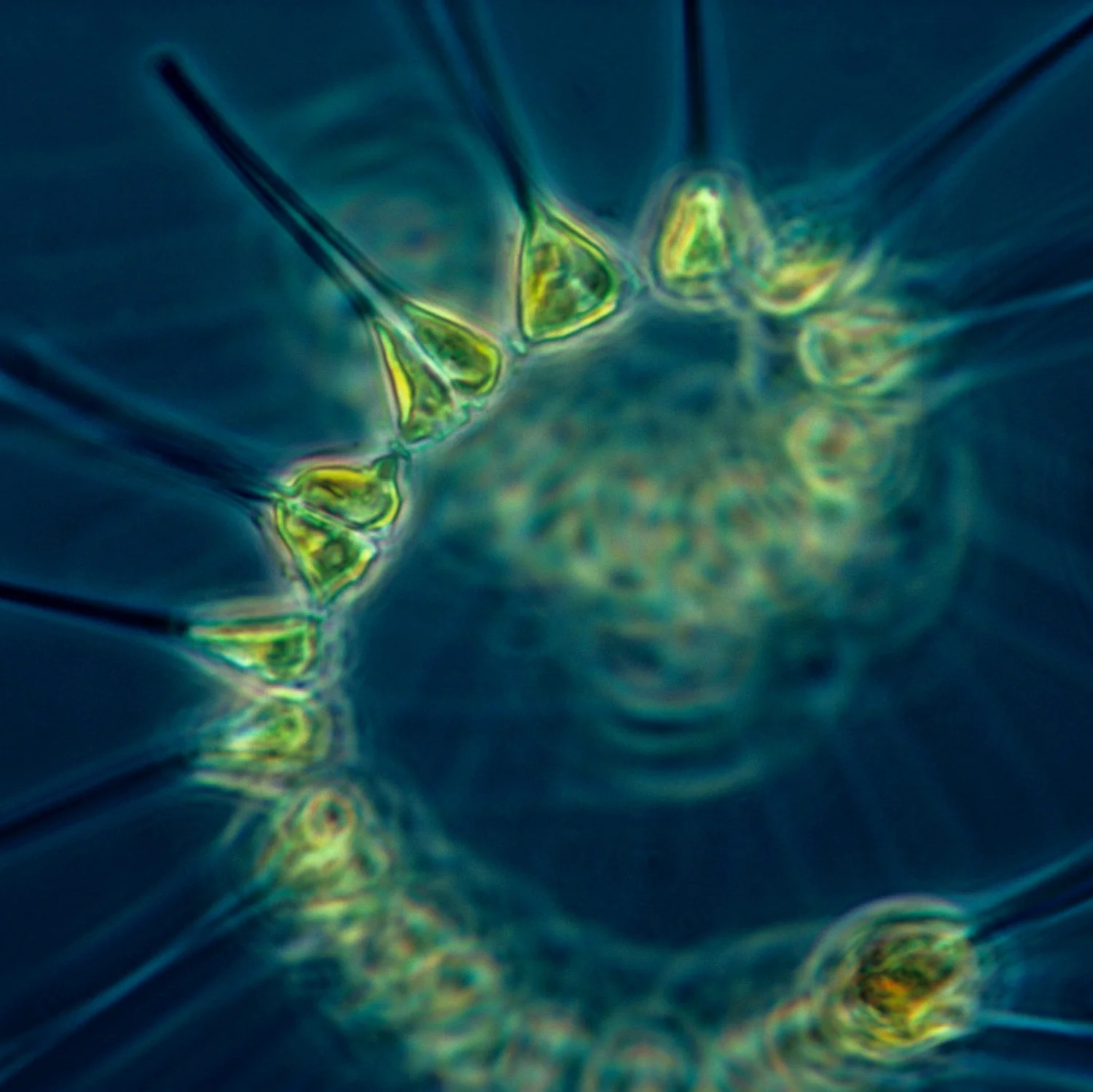What is the function of phytoplankton?
As photosynthetic organisms, phytoplankton represent primary producers that serve as the main source of food for many marine organisms. Filter feeders such as sponges, corals, small fish, and crustaceans all feed upon phytoplankton.
What exactly are phytoplankton?
Phytoplankton refer to unicellular organisms capable of photosynthesis. Phytoplankton includes both algae and bacteria that utilize photosynthesis to produce their own food.
What are the major types of phytoplankton?
There are three main types of phytoplankton. These include dinoflagellates, diatoms, and cyanobacteria. These unicellular organisms use photosynthesis to produce their own energy.
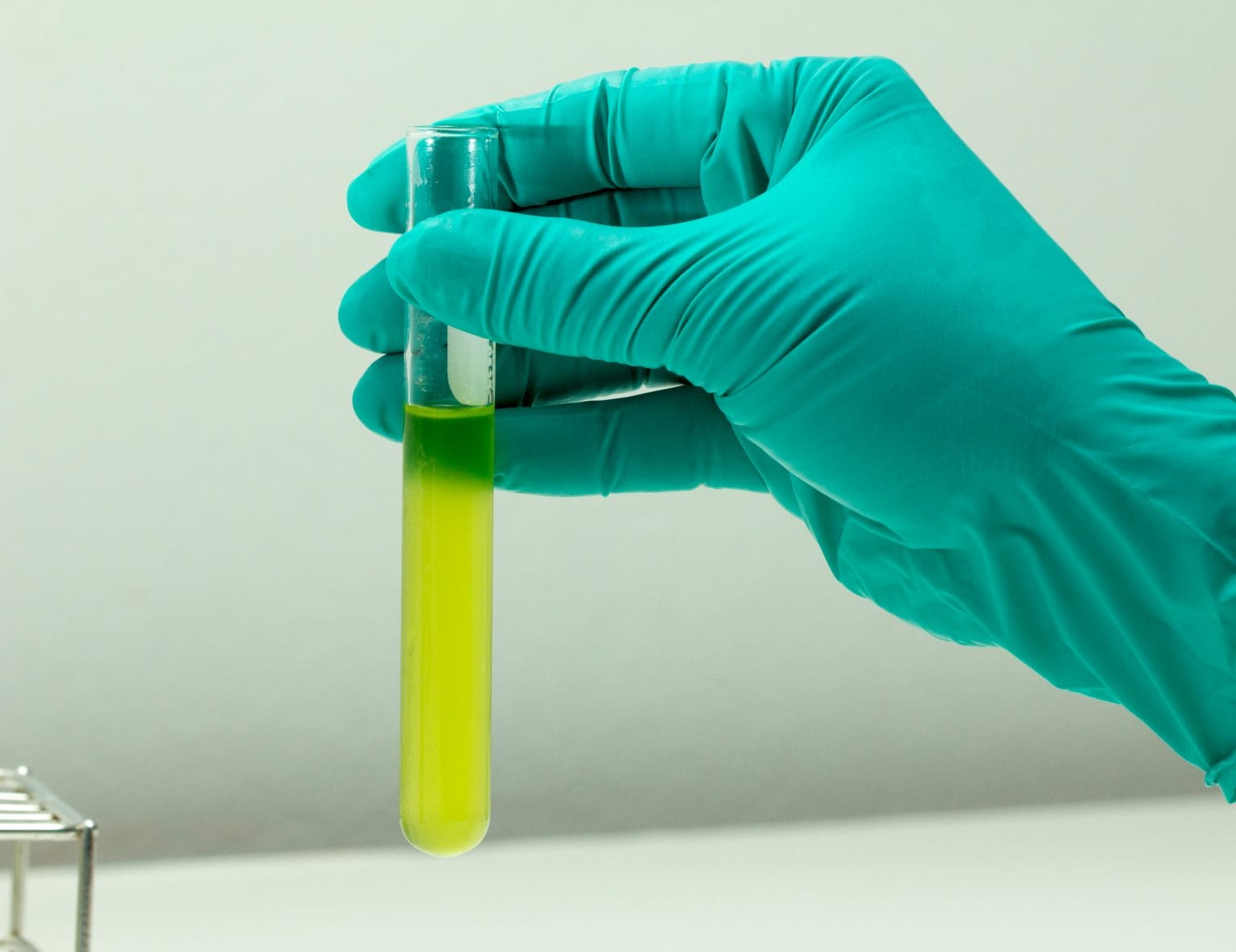 let’s just acknowledge here that there are no single, perfect phytoplankton species. Given the different nutritional demands and feeding requirements of diverse marine life, there isn’t even a truly perfect blend. It is possible, however, to strike a reasonable balance by carefully blending the “right” cohort of species in the “right” proportions to meet the basic needs of a wide variety of captive animals. Such a balance, we believe, was achieved with OceanMagik. This unique blend formerly included the following:]
let’s just acknowledge here that there are no single, perfect phytoplankton species. Given the different nutritional demands and feeding requirements of diverse marine life, there isn’t even a truly perfect blend. It is possible, however, to strike a reasonable balance by carefully blending the “right” cohort of species in the “right” proportions to meet the basic needs of a wide variety of captive animals. Such a balance, we believe, was achieved with OceanMagik. This unique blend formerly included the following:]
- NANNO (Nannochloropsis gaditana), a tiny unflagellated yellow/green algae of 1-5 microns in size; a great source of the polyunsaturated Omega-3 fatty acid eicosapentaenoic acid (EPA) and a heavy consumer of nitrogenous wastes (e.g. ammonia and nitrate).
- TET (Tetraselmis sp.), green biflagellated algae of 6-10 microns in size; a good source of lipids, amino acids and the Omega-3 fatty acid docosahexaenoic acid (DHA) as well as EPA.
- ISO (Isochrysis galbana), golden brown biflagellate algae of 10-14 microns in size; rich in DHA, it is often used to enrich live foods such as copepods and brine shrimp and is readily accepted by many filter-feeding bivalve mollusks (e.g. clams, scallops, oysters and mussels).
- THAL (Thalassiosira weissflogii), a relatively large, green/brown unflagellated algae of 5-32 microns in size, which is more available to large-particle filter-feeders; this diatom consumes excess silicate.
And the new formula? Simply swap the centric diatom Thalassiosira weissflogii with the similarly sized pennate diatom Phaeodactylum tricornutum, otherwise known as PHAEO.
Phytoplankton Species and their individual Strengths
When purchasing live foods for your tank, many people simply take the shop employee’s advice when handed a jar of unidentified copepods for their reef tank. Most do not research into the different species of copepods, we just understand that they are a major element of our clean up crews and that our fish love snacking on them. But, what if you want to actually make sure you are getting the best option available, and not just whatever the local fish shop has in stock this week? Many aquarists turn to buy the copepods online for this reason, as online retailers typically understand the differences between species and explain them on each individual product’s page. After reading the pages of each individual species, many are left wondering “what do copepods eat?” Aside from detritus and fish food, most species we add to our tanks also eat algae and phytoplankton. But, there is also about a half dozen species of phyto available to hobbyists. Here, we will go into detail on each species and their benefits to your tank. These live foods can be added to your tank to do more than just feed microfauna. Phytoplankton in and of itself discourages nuisance algae growth and coral polyp extension and feeding!
 Isochrysis Galbana
Isochrysis Galbana
Iso is a mobile alga, two flagella are used for locomotion. It is high in DHA (Docosahexaenoic Acid), which plays a major role in nervous system development. Fucoxanthin, a carotenoid found in these single-celled algae, is being found to make cancer and tumor cells undergo programmed cell death. In addition, Fucoxanthin was shown to reduce weight and decrease insulin resistance in animals diagnosed with obesity. And let’s be honest, we all have some fish that are a little chubby! Due to its nutritional value, it is one of the phytoplankton used to enrich copepods, Brine, mysids, rotifers, or other live foods to make them more beneficial to the consumers. Iso is also one of the most prominent feeds used in bivalve (such as clam) hatchery facilities due to its nutritional profile. So, this is a great option for feeding your tank! Nearly all bivalves, corals, and filter feeders will accept Isochrysis.
Nannochloropsis
This is a genus comprised of 6 different species that can only be distinguished from one another by genetic sequence analysis. Because of this, most cultures contain more than one species of Nano. Unlike Iso, these algae are not mobile and can actually be found in fresh, brackish, and full saltwater environments. As such, freshwater clams and filter feeders can also benefit from the freshwater cultures of Nano. Nannochloropsis is able to accumulate huge amounts of astaxanthin, a pigment that improves red, yellow, and orange coloration. Zeaxanthin is carotenoid alcohol, and can also be found in Nano. It is also a pigment that enhances red, yellow, and orange colors. Spirulina is another source of this pigment. Finally, the pigment Canthaxanthin is also present in this phytoplankton. As with the other two substances, it enhances gold, yellow, and orange colors. Nano is also rich in EPA. Basically, this phytoplankton can help your livestock’s pink, red, orange, and yellow colors deepen and pop. Who doesn’t love naturally brilliantly colored animals?
Due to the fast-growing and quick reproduction of Nano, it can be added to the aquarium to hinder the growth of unwanted pest algae. It will easily outcompete these other species and is easily caught and consumed by all filter feeders, so it will not become a nuisance in and of itself. These properties, along with its three-month shelf life when refrigerated, make it a top choice for aquarists. So, what do copepods eat? Well, this phytoplankton may be one of the best options!
Tetraselmis Suecica
Tet is single-celled, motile algae. Although not as much information is easily available on this species, it is known to be rich in lipids, DHA, EPA, and arginine. Arginine is an important amino acid, as it is a neurotransmitter that aids in blood circulation. It also has a role in injury healing, removing toxins like ammonia from the body, and maintaining a healthy immune system. To keep your fish and inverts in top shape, it is easy to understand why an arginine-rich diet is beneficial. It is also one of the most carbohydrate-rich microalgae, which means it has more digestible glucose than other phytoplankton. Pods and other foods enriched with Tet are an easy addition to your feeding regimen that can keep your fish as healthy as possible!
Thalassiosira Weissflogii

Also occurring in fresh, brackish, and full saltwater, Thal is technically a diatom that is not motile. It can grow in less-than-stellar water conditions, including in chlorinated water! Iron, nickel, zinc, nitrogen, and silicates are all used by Thalassiosira, and these are limiting factors for its growth. This means if you discover that you have high metal concentrations in your tank through ICP or lab testing, adding Thal can greatly benefit your tank by removing these potential dangers. Due to the fact that it actively uses and depletes silicate in aquaria, it can be dosed to outcompete nuisance diatoms that grow over our sand and rocks. Thal is preferred by many filter feeders as it is larger in size than the other species on this list and can be used by older fry and larval invertebrates. And, individuals attach to one another and can form longer chains of Thal, so even the coarsest of filter feeders can utilize this species.
Closing Thoughts
As we can see from the above information, live phytoplankton has many benefits to offer your tank and livestock. If you find yourself wondering “what do copepods eat,” “what else can I feed my corals,” “how can I grow my pod population,” or “what are some natural defenses to nuisance algae” it may be time to look towards implementing a dosing regimen for phytoplankton. If you want to get the best bang for your buck, many companies are now offering mixed-species cultures to feed your livestock, so you get the benefits of each individual phyto. Some even include species not covered in this article, but these four types are some of the most prominent and beneficial ones available to hobbyists.
What are Phytoplankton?
Derived from the Greek wordsphyto(plant) andplankton(made to wander or drift), phytoplankton are microscopic organisms that live in watery environments, both salty and fresh.
Some phytoplankton are bacteria, some are protists, and most are single-celled plants. Among the common kinds arecyanobacteria, silica-encased diatoms,dinoflagellates,green algae, and chalk-coated coccolithophores.

Like land plants, phytoplankton have chlorophyll to capture sunlight, and they use photosynthesis to turn it into chemical energy. They consume carbon dioxide, and release oxygen. All phytoplankton photosynthesize, but some get additional energy by consuming other organisms.
Phytoplankton growth depends on the availability of carbon dioxide, sunlight, and nutrients. Phytoplankton, like land plants, require nutrients such as nitrate, phosphate, silicate, and calcium at various levels depending on the species. Some phytoplankton canfix nitrogenand can grow in areas where nitrate concentrations are low. They also require trace amounts of iron which limits phytoplankton growth in large areas of the ocean because iron concentrations are very low. Other factors influence phytoplankton growth rates, including water temperature and salinity, water depth, wind, and what kinds of predators are grazing on them.
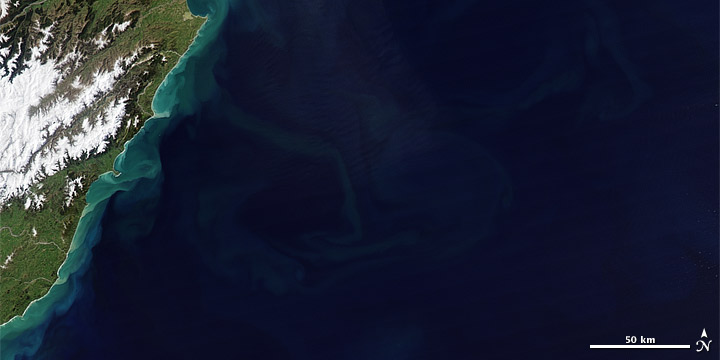
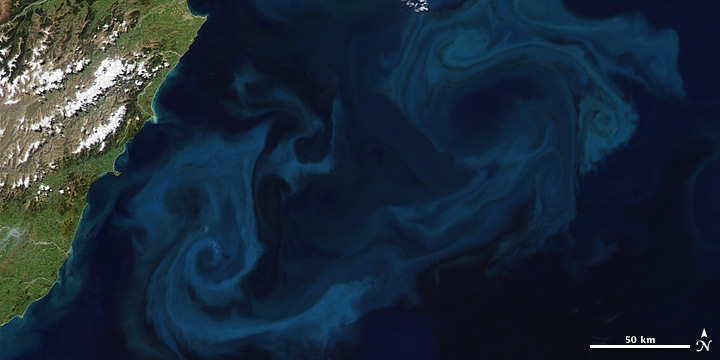
When conditions are right, phytoplankton populations can grow explosively, a phenomenon known as a bloom. Blooms in the ocean may cover hundreds of square kilometers and are easily visible in satellite images. A bloom may last several weeks, but the life span of any individual phytoplankton is rarely more than a few days.
Importance of phytoplankton
The food web
Phytoplankton are the foundation of theaquatic food web,theprimary producers, feeding everything from microscopic, animal-like zooplankton to multi-ton whales. Small fish and invertebrates also graze on the plant-like organisms, and then those smaller animals are eaten by bigger ones.
Phytoplankton can also be the harbingers of death or disease. Certain species of phytoplankton produce powerful biotoxins, making them responsible for so-called “red tides,” or harmful algal blooms. These toxic blooms can kill marine life and people who eat contaminated seafood.
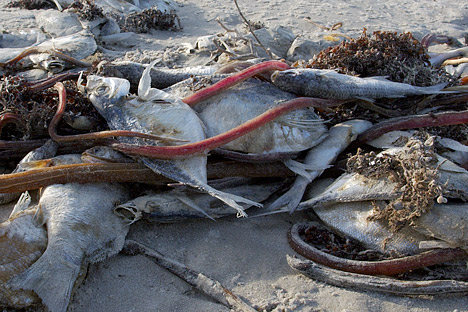
Phytoplankton cause mass mortality in other ways. In the aftermath of a massive bloom, dead phytoplankton sink to the ocean or lake floor. The bacteria that decompose the phytoplankton deplete the oxygen in the water, suffocating animal life; the result is adead zone.
Climate and the Carbon Cycle
Through photosynthesis, phytoplankton consume carbon dioxide on a scale equivalent to forests and other land plants. Some of this carbon is carried to the deep ocean when phytoplankton die, and some is transferred to different layers of the ocean as phytoplankton are eaten by other creatures, which themselves reproduce, generate waste, and die.
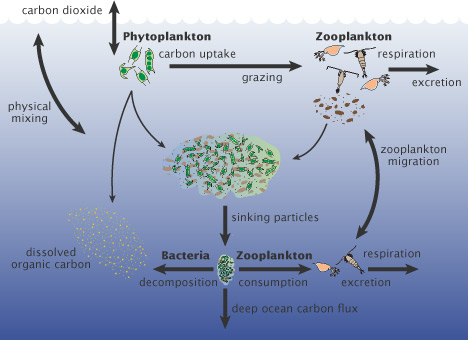
Worldwide, this “biological carbon pump” transfers about 10 gigatonnes of carbon from the atmosphere to the deep ocean each year. Even small changes in the growth of phytoplankton may affect atmospheric carbon dioxide concentrations, which would feed back to global surface temperatures.
The Aquatic Food Web
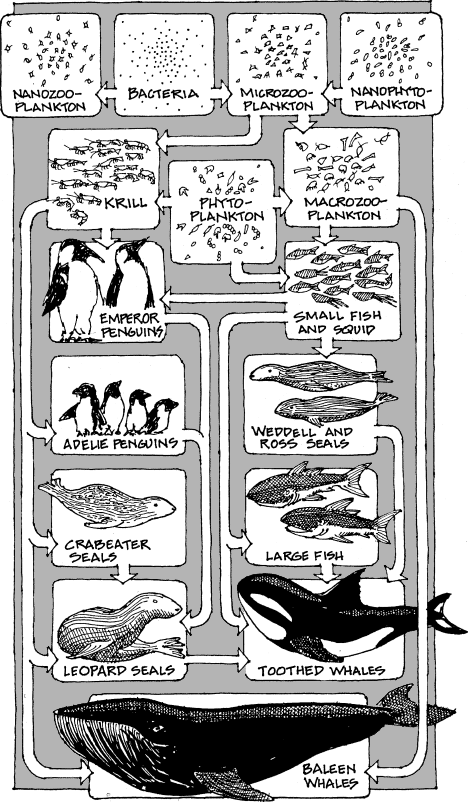
Studying phytoplankton
Phytoplankton samples can be taken directly from the water at permanent observation stations or from ships. Sampling devices include hoses and flasks to collect water samples, and sometimes, plankton are collected on filters dragged through the water behind a ship.
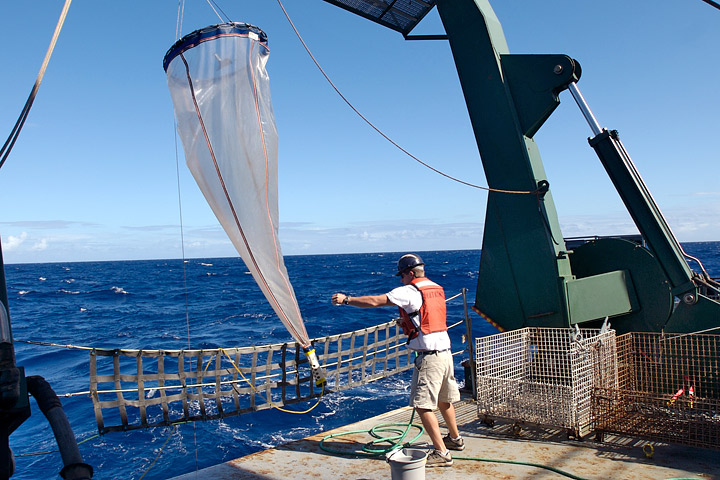
Samples may be sealed and put on ice and transported for laboratory analysis, where researchers may be able to identify the phytoplankton collected down to the genus or even species level through microscopic investigation or genetic analysis.
Although samples taken from the ocean are necessary for some studies, satellites are pivotal for global-scale studies of phytoplankton and their role in climate change. Individual phytoplankton are tiny, but when they bloom by the billions, the high concentrations of chlorophyll and other light-catching pigments change the way the surface reflects light.


In natural-color satellite images (top), phytoplankton appear as colorful swirls. Scientists use these observations to estimate chlorophyll concentration (bottom) in the water. These images show a bloom near Kamchatka on June 2, 2010. (Images by Robert Simmon and Jesse Allen, based onMODISdata.)
The water may turn greenish, reddish, or brownish. The chalky scales that cover coccolithophores color the water milky white or bright blue. Scientists use these changes in ocean color to estimate chlorophyll concentration and the biomass of phytoplankton in the ocean.
Global Patterns and Cycles
Differences from place to place
Phytoplankton thrive along coastlines and continental shelves, along the equator in the Pacific and Atlantic Oceans, and in high-latitude areas. Winds play a strong role in the distribution of phytoplankton because they drive currents that cause deep water, loaded with nutrients, to be pulled up to the surface.
These upwelling zones, including one along the equator maintained by the convergence of the easterly trade winds, and others along the western coasts of several continents, are among the most productive ocean ecosystems. By contrast, phytoplankton are scarce in remote ocean gyres due to nutrient limitations.

Phytoplankton are most abundant (yellow, high chlorophyll) in high latitudes and in upwelling zones along the equator and near coastlines. They are scarce in remote oceans (dark blue), where nutrient levels are low. This map shows the average chlorophyll concentration in the global oceans from July 2002–May 2010.View animation:small(5 MB)large(18 MB). (NASA image by Jesse Allen & Robert Simmon, based on MODIS data from the GSFCOcean Colorteam.)
Differences from season to season
Like plants on land, phytoplankton growth varies seasonally. In high latitudes, blooms peak in the spring and summer, when sunlight increases and the relentless mixing of the water by winter storms subsides. Recent research suggests the vigorous winter mixing sets the stage for explosive spring growth by bringing nutrients up from deeper waters into the sunlit layers at the surface and separating phytoplankton from their zooplankton predators.
In the subtropical oceans, by contrast, phytoplankton populations drop off in summer. As surface waters warm up through the summer, they become very buoyant. With warm, buoyant water on top and cold, dense water below, the water column doesn’t mix easily. Phytoplankton use up the nutrients available, and growth falls off until winter storms kick-start mixing.
In lower-latitude areas, including the Arabian Sea and the waters around Indonesia, seasonal blooms are often linked to monsoon-related changes in winds. As the winds reverse direction (offshore versus onshore), they alternately enhance or suppress upwelling, which changes nutrient concentrations. In the equatorial upwelling zone, there is very little seasonal change in phytoplankton productivity.

In spring and summer, phytoplankton bloom at high latitudes and decline in subtropical latitudes. These maps show average chlorophyll concentration in May 2003–2010 (left) and November 2002–2009 (right) in the Pacific Ocean. (NASA images by Jesse Allen & Robert Simmon, based on MODIS data from the GSFCOcean Colorteam.)
Differences from year to year
The biggest influence on year-to-year differences in global phytoplankton productivity is the El Niño-Southern Oscillation (ENSO) climate pattern. ENSO cycles are significant changes from typical sea surface temperatures, wind patterns, and rainfall in the Pacific Ocean along the equator.
During EL Niño events, phytoplankton productivity in the equatorial Pacific declines dramatically as the easterly trade winds that normally drive upwelling grow still or even reverse direction. The transition between El Niño and its counterpart, La Niña, is sometimes accompanied by a dramatic surge in phytoplankton productivity as upwelling of nutrient-rich deep water is suddenly renewed.

During an El Niño (December 1997, left), upwelling in the equatorial Pacific slows, reducing phytoplankton density. In contrast, a La Niña increases upwelling in the same area, enhancing phytoplankton growth (December 1998, right). (NASA image by Jesse Allen & Robert Simmon, based on SeaWiFS data from the GSFCOcean Colorteam.)
El Niño events influence weather patterns beyond the Pacific; in the eastern Indian Ocean around Indonesia, for example, phytoplankton productivity increases during El Niño. Productivity in the Gulf of Mexico and the western sub-tropical Atlantic has increased during El Niño events in the past decade, probably because increased rainfall and runoff delivered more nutrients than usual.
Compared to the ENSO-related changes in the productivity in the tropical Pacific, year-to-year differences in productivity in mid- and high latitudes are small.
Long-term changes in phytoplankton
Productivity
Because phytoplankton are so crucial to ocean biology and climate, any change in their productivity could have a significant influence on biodiversity, fisheries and the human food supply, and the pace of global warming.
Many models of ocean chemistry and biology predict that as the ocean surface warms in response to increasing atmospheric greenhouse gases, phytoplankton productivity will decline. Productivity is expected to drop because as the surface waters warm, the water column becomes increasinglystratified; there is less vertical mixing to recycle nutrients from deep waters back to the surface.

About 70% of the ocean is permanently stratified into layers that don’t mix well. Between late 1997 and mid-2008, satellites observed that warmer-than-average temperatures (red line) led to below-average chlorophyll concentrations (blue line) in these areas. (Graph adapted fromBehrenfeld et al. 2009by Robert Simmon.)
Over the past decade, scientists have begun looking for this trend in satellite observations, and early studies suggest there has been a small decrease in global phytoplankton productivity. For example, ocean scientists documented an increase in the area of subtropical ocean gyres—the least productive ocean areas—over the past decade. These low-nutrient “marine deserts” appear to be expanding due to rising ocean surface temperatures.
Species composition
Hundreds of thousands of species of phytoplankton live in Earth’s oceans, each adapted to particular water conditions. Changes in water clarity, nutrient content, and salinity change the species that live in a given place.
Because larger plankton require more nutrients, they have a greater need for the vertical mixing of the water column that restocks depleted nutrients. As the ocean has warmed since the 1950s, it has become increasingly stratified, which cuts off nutrient recycling.
Continued warming due to the build up of carbon dioxide is predicted to reduce the amounts of larger phytoplankton such as diatoms), compared to smaller types, like cyanobacteria. Shifts in the relative abundance of larger versus smaller species of phytoplankton have been observed already in places around the world, but whether it will change overall productivity remains uncertain.

As carbon dioxide concentrations (blue line) increase in the next century, oceans will become more stratified. As upwelling declines, populations of larger phytoplankton such as diatoms are predicted to decline (green line). (Graph adapted fromBopp 2005by Robert Simmon.)
These shifts in species composition may be benign, or they may result in a cascade of negative consequences throughout the marine food web. Accurate global mapping of phytoplankton taxonomic groups is one of the primary goals of proposed future NASA missions like the Aerosol, Cloud, Ecology (ACE) mission.
